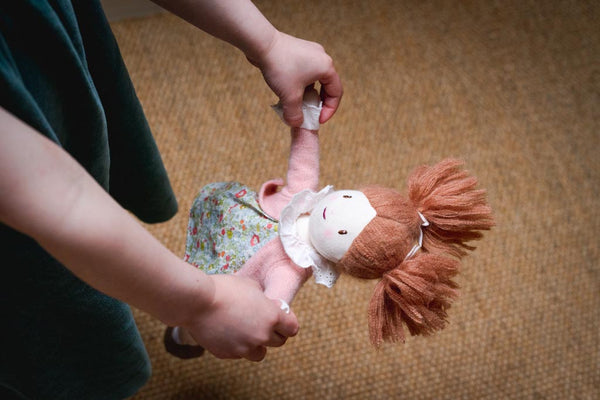Rag dolls | Comfort and companionship

Rag dolls are old.
They are some of the earliest toys. This one, found in Egypt, dates back to Roman times. But we can be sure that this wasn’t the first time a child explored the urge to nurture and protect.
The very first toys were natural materials. Sticks and stones, sand and water.
Play was functional. Sticks were for poking and stones for stacking.
But at some point along the evolutionary road, objects became symbols. This pine cone is a wolf. Those acorns are sheep.
And, most importantly of all, This bundle is a baby.
Cradling a big stone or a branch isn’t much fun. Perhaps the first rag doll was a balled-up animal skin. Whatever it was, prehistoric parents saw that their children craved something to cuddle, a soft companion to carry with them. And so it wasn’t long before the first rags were stitched together to make a doll.
What are rag dolls?
As the name suggests, rag dolls were traditionally made from leftover scraps of cloth.
Modern equivalents try to convey some of this rough charm. Eyes are stitched rather than plastic; bodies are simpler and less realistic.
But, somehow, it makes these unembellished dolls easier to love. Soft and floppy, made from cotton and wool, they are huggable companions to join you on every adventure.
Read more about transitional objects.

How do children use them?
Rag dolls aren’t just for cuddles. Here are some of the ways your child might use this most versatile of toys.
- Comfort and security. Soft toys, like rag dolls, can provide a sense of comfort and security for your child. This is especially important in new or unfamiliar situations. Read more about transitional objects.
- Social skills. Playing with dolls can help your child develop social skills as she enacts dialogues, role-plays, and practices nurturing behaviours.
- Motor skills. Dressing the dolls or manipulating their soft limbs can enhance fine motor skills.
- Imagination. Rag dolls can be a catalyst for imaginative play, which is crucial for cognitive development.
- Emotional expression. Your child often uses dolls to express her feelings, act out scenarios, or process events she's experienced, aiding in emotional development.
- Symbolic play. Having a toy that, in some way, represents or resembles your child can boost her self-esteem and provide a tool for self-exploration. Read more about symbolic play.

Choose the right rag doll
Old-fashioned rag dolls
Traditional rag dolls are often larger, providing a sizeable companion for your child. With their soft bodies and comforting weight, they are perfect for hugging at bedtime or bringing along on family outings.
Mini rag dolls
Fit into a bag or carry in your hand. Mini rag dolls are a smaller version of their traditional counterparts. They are perfect for playdates, trips, or just to accompany your child during errands. Their size makes them less cumbersome and ideal for younger children.
Matchbox rag dolls
These pocket-sized friends are small enough to join you on any adventure and are perfect for those moments when your child needs something comforting to squeeze. Discreet and adorable, they are a secret companion for your child wherever she goes.
How to make a rag doll
It's a big project - and it takes some skill - but with a little help from you, your child can make her very own rag doll. Younger children will do no more than choose the fabric and thread but school-age children can have a go at the sewing.
Here's a basic method:
- Design & pattern. Start by sketching a simple doll shape or using a pre-made pattern.
- Cutting. Fold a piece of cloth in half and trace the pattern onto it. Cut two identical doll shapes from the fabric.
- Sewing. With the right sides of the fabric facing each other, sew around the edges, leaving a gap for stuffing.
- Turning & stuffing. Turn the doll right side out through the gap and stuff it with fibre fill or another suitable material.
- Closing. Hand-stitch the opening closed.
- Details. Add facial features using embroidery, buttons, or fabric paint. Hair can be made from yarn, wool, or fabric strips. Clothes can be sewn separately and then dressed onto the doll or directly sewn onto the doll's body.
 Final word
Final word
The phrase ‘timeless classic’ gets overused.
But rag dolls have been a childhood favourite since time out of mind.
Your child instinctively knows how to play with them. They meet a need to nurture that’s at the core of our being.
Watching your child with her rag doll, you're witnessing a tradition that spans generations, connecting her to the children of the past and the future.
How comforting to know that some things never change.





